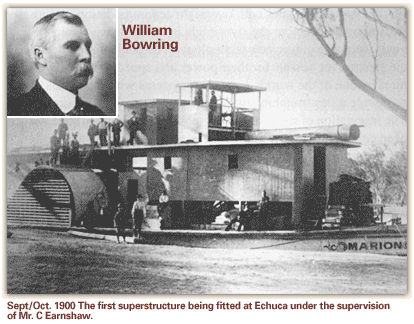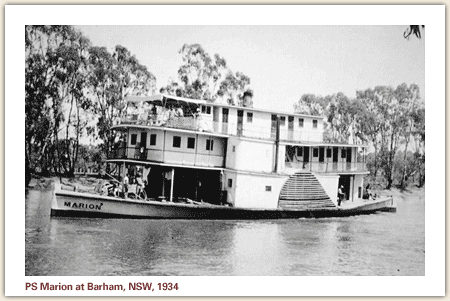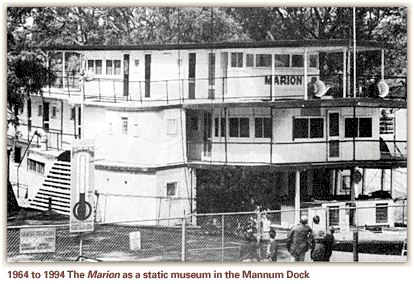
One of the first paddle steamers to run cruises on the Murray River, the PS Marion is one of the world’s only operational, heritage, steam driven, wood fired, side paddle steamers with overnight passenger accommodation still operating.
Marion’s life has been full of changes.
In 1896, Milang shipbuilder A.H. Landseer was commissioned to build a steamer by Mr George Swan Fowler, a prominent Adelaide business man. It would appear that Mr Fowler had intended to use the steamer as both a work boat and also a pleasure craft. Unfortunately Mr Fowler died soon after building began, and his trustees decided that the hull should be completed and offered for sale as a barge. It was named Marion and first floated in February 1897.
Designed and built in the context of the Murray Darling river system, she has spent all her life on the river and has become recognised as a part of it. Her continuing and intimate link with the River Murray is of great significance.
PS Marion was recognised as one of the flag ships of river transport and demonstrates the organisation and operation of an intact example of its type. PS Marion is the third oldest Australian vessel on Lloyds Register. The vessel reflects the evolution of the economic, trade, transportation and social development of the Murray Darling system and its regions during the twentieth century.
The process of alteration over the life of the vessel demonstrates the flexibility and adaptability of river steamers and their owners to meet the challenge of changing local conditions. The Marion’s current configuration is a culmination of these changes, and represents the most feasible function for a mid twentieth century river boat. A number of significant river personalities and organisations, which have contributed to the development of the Murray Darling system, have been associated with the vessel, as captains, members of the crew or owners.

The vessel was used as the setting for the ceremonies which marked the initiation of the locking on the river, marking one of the first unified acts of the States under the Commonwealth. In association with the event, a range of notable Australian political figures and dignitaries from the States and Commonwealth, including the Prime Minister Andrew Fisher, and the Attorney General Billy Hughes, cruised the river on the Marion.

The distinctive character of the vessel has resulted from its piece-meal growth and the often crude construction technique utilised. All contribute to a general unity of form. The heart of the Marion is its steam power plant which is integral with the significance of the vessel and heightens the sensory experience associated with its operation.
William Bowring kept a store in Wentworth and also traded up and down the Darling, selling goods from a paddle steamer. In early 1900 WM Bowring & Co. bought the Marion after his previous steamer had caught fire and burnt to the waterline. The barge was towed to Echuca, where Bowring built a superstructure so it could work as a store and Marion entered her working life as a hawking steamer. Bowring imported her engine, which was built by Marshall & Sons of Gainsborough, England in 1900. Marion is still powered by its original engine.
PS Marion left Echuca as a fully independent working steamer in October 1900 and returned to Wentworh. From here she worked the Darling trade, taking supplies to settlements and stations along the river.
In 1908, the Marion was sold to Ben Chaffey of Renmark, who stripped off her storebuildings and rebuilt her with accommodation to carry eight passengers, the captain and crew as well as carry cargo. Chaffey also had two barges specially built for her to tow.
Over the years, Marion went through many changes of ownership. Her shape and function also changed many times as she evolved from cargo with passengers to passengers with cargo and eventually to a passenger boat alone. In her final working guise Marion had accommodation spread over three decks, lounges on the top and middle decks with the dining room on the main deck.
Marion was best known during her days as one of the passenger steamers of the Murray Shipping Limited. In December 1934 she left Morgan for the first of what became regular Summer cruises. She went upstream as far as Renmark, then down to Goolwa and back to Morgan.
After Murray Shipping Limited went into liquidation in 1952, Marion was sold a number of times and spent some years as a floating boarding house in Berri. In 1963, Marion was bought by the National Trust to be used as a memorial to the River Navigation Era. She sailed down river to Mannum under her own steam on what was then thought to be her last voyage. Captain Bill Drage, who captained the Marion during her last years as a passenger steamer, took the helm on that voyage.

For over thirty years Marion rested in the historic Randell Dry Dock at Mannum, where the local branch of the National Trust maintained her as a static museum. In 1989 the Mannum community and Council decided that the best way to preserve the Marion for future generations was to conserve and restore the boat to being fully operational. The Mannum Dock Museum was appointed to manage and develop the facilities and opportunities of PS Marion and Randell Dry Dock as the core of the Mannum Dock Museum of River History.
Major restoration work was undertaken with great love and attention to detail. This work has involved many tens of thousands of volunteer man hours. The superstructure has been restored to what it was in her heyday as a passenger steamer, with cabins, lounges, dining room, galley and bathrooms. Marion was recommissioned in November 1994.
Based in Mannum, the steamer is open to the public every day and runs passenger trips throughout the year. It provides a unique opportunity to experience the thrills and mysteries of the golden years of the river boats and will go on doing so for many years to come.